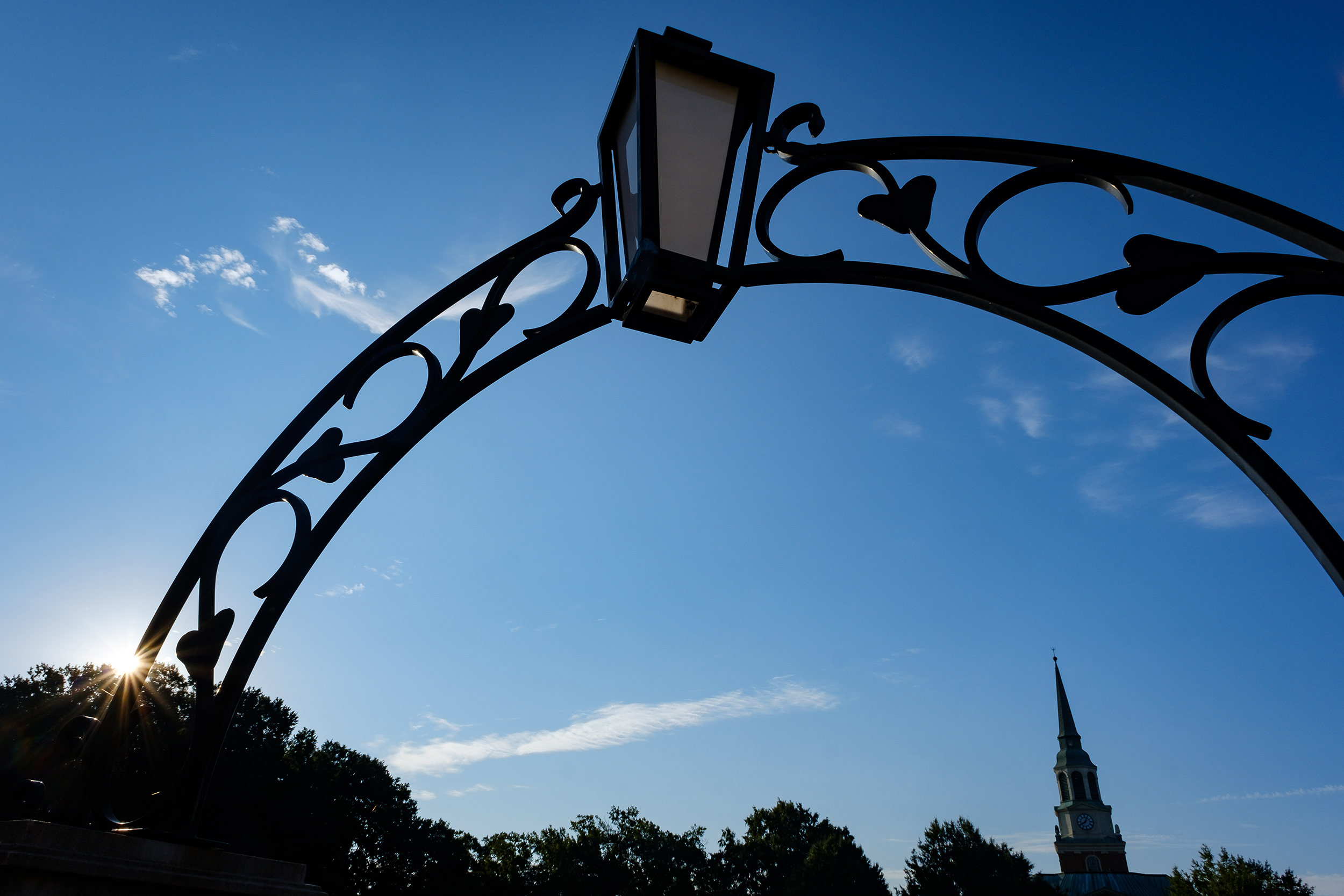Nathan O. Hatch installed as 13th President of Wake Forest
President Nathan O. Hatch pledged in his inaugural address on October 20 to draw upon Wake Forest’s traditional strengths to further build a vibrant learning community to meet contemporary challenges.
“Let us rekindle Wake Forest’s finest tradition: a face-to-face community, grounded in the liberal arts, passionate about professional education, and committed to living out the values we profess individually and as a community,” he said. “I am confident that Wake Forest can build this kind of learning community at the highest levels of academic life. It is our heritage, our identity, and our greatest opportunity.”
In front of about 2,000 faculty, staff, students, alumni, and other guests in Wait Chapel, Hatch was officially installed as Wake Forest’s thirteenth president by Board of Trustees Chairman L. Glenn Orr. Trustee Murray C. Greason, Jr. (’59, JD ’62), chairman of the Presidential Selection Committee, and Provost Emeritus Edwin G. Wilson (’43) invested Hatch with the Presidential Collar of State. He was briefly joined at the podium by his wife, Julie, before beginning his inaugural address.
North Carolina First Lady Mary Pipines Easley (’72, JD ’75) and Winston-Salem Mayor Allen Joines were among the dignitaries offering greetings to Hatch. Representatives from more than one hundred colleges and universities were also present, including the University of Notre Dame’s current president, Father John I. Jenkins, and past two presidents, Father Theodore Hesburgh and Father Edward Malloy.
Hatch, 59, was previously provost at Notre Dame. He began his tenure as president on July 1, succeeding Thomas K. Hearn, Jr., who retired after twenty-two years as president. Hearn, who underwent surgery for a brain tumor in the winter of 2004, recently had additional surgery and is recovering at home.
In his inaugural address, Hatch noted the challenges facing college and professional students. “Students today are whipsawed between an ethic to serve and an ethic to achieve. Fewer come to college looking to find a philosophy of life, and fewer still find their college to be a once-in-a-lifetime oasis of learning…. Similarly, professional life today is undergoing turbulent change as market forces threaten to overwhelm the traditional roles — and levels of satisfaction — for lawyers, physicians, accountants, and other service professionals.”
Other trends — from globalization to religious extremists to terrorism to scandals in government and the church — shape today’s students, and the education they expect. Wake Forest can respond to those trends, not by giving up what some may see as a “quaint memory” of a community of learning, but by drawing from the “wellsprings of our own tradition,” he said. “Wake Forest’s finest tradition is that of a community, personal in scale, committed to learning, to character formation, and to diversity. A vibrant learning community, one that weds knowledge and experience, can also be our greatest gift to contemporary society.”
He outlined three facets toward building what he called a “community of learning,” starting with the University’s faculty and the learning environment they create for students. “We must recruit and sustain superb faculty and build an enviable level of support for their work. We must be innovative in thinking about the curriculum and the academic major, comparing our programs with the best. In an age of narrow specialization, we must foster interdisciplinary engagement and integrated learning. We must enhance our support for the library and research, investing in certain centers of excellence… None of these goals can be achieved by simply sustaining our current efforts. We must be rigorous in our evaluation, focused in our planning, and bold in our building an endowment appropriate to a University of this scope and quality.”
The second challenge, he said, is to build a more diverse community to prepare students for leadership in a diverse world. “In welcoming religious and ethnic diversity, Wake Forest must also keep faith with its own heritage: to educate talented young people who do not necessarily come from privileged backgrounds. Wake Forest has long been a beacon of opportunity for people of modest means, who were smart and ambitious. Wake Forest has been a place of quality but not pretension. We must sustain that institutional heritage with generous scholarship support.”
Finally, the University must uphold moral formation and Pro Humanitate as essential to its mission, he said. “Learning at this place should always grapple with transcendent and ultimate questions: What can I know? In what can I believe? To what should I be committed? Wake Forest’s religious heritage, far from being a liability, provides a middle ground where vital religious traditions can engage modern thought in a climate of academic freedom.”
Hatch had served on the history faculty at Notre Dame since 1975 and had been Provost, the University’s second-highest ranking position, since 1996, the first Protestant to hold that position. He was also the Andrew V. Tackes Professor of History. He is regularly cited as one of the most influential scholars in the study of the history of religion in America and won national acclaim for his 1989 book, The Democratization of American Christianity. He is also the author, editor, or co-editor of seven other books on religion.
He and his wife, Julie, a former public school teacher, have three children: Gregg, a 1997 graduate of Notre Dame who is a health care administrator in South Bend, Indiana; David, a 2000 Notre Dame graduate who works for a financial organization in Chicago; and Beth, a junior at Notre Dame majoring in American Studies and theology. In July, the Hatches welcomed their first grandchild, Lucia Jean Hatch, daughter of Gregg and his wife, Kathy.
Categories: University Announcements
Wake Forest News
336.758.5237
media@wfu.edu
Meet the News Team
Wake Forest in the News
Wake Forest regularly appears in media outlets around the world.




